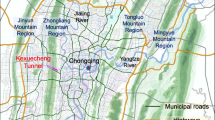Abstract
During the construction of New Yungchuen Tunnel, a major water inflow was encountered and the advance was abandoned. Further advances were attempted and again abandoned. Following detailed investigations, the problem area was determined as a very voided marble layer. The paper describes the use of hot bituminous grouting followed by cement and chemical grouting to both reduce the water inflow to acceptable volumes and pressures and also to reduce the convergence. In addition, the design of the tunnel was changed to include the construction of a larger circular tunnel through which the general horse-shoe shaped tunnel would subsequently pass.
Résumé
Pendant la construction du tunnel de New Yungchuen, une venue d’eau importante a été rencontrée et le creusement dut être abandonné. De nouvelles reprises de creusement ont été tentées et à nouveau abandonnées. Après des investigations détaillées, la zone problématique a été identifiée comme un niveau de marbre comportant des vides importants. L’article décrit l’utilisation de produits d’injection bitumineux chauds suivis par l’injection de coulis de ciment et de produits chimiques à la fois pour réduire les venues d’eau et les pressions et aussi pour diminuer la convergence. De plus, la conception du tunnel a été modifiée avec pour objectif de construire un tunnel circulaire plus grand au travers duquel le tunnel de section en fer à cheval pourrait ensuite s’insérer.














Similar content being viewed by others
References
Bieniawski ZT (1984) Design process in rock engineering. Rock Mech Rock Eng 17(3):183–190
Fu R, Hsueh WC (2003) The countermeasures to break through the New Yungchuen Tunnel high pressure water ingress problem. In: Proceedings of the technical workshop on harnessing huge water inflow at the New Yungchuen Tunnel, Taipei, pp 1–18 (in Chinese)
Fu R, Sun LJ, Wang CL (2000) Catastrophic water inflow in the New Yungchuen Tunnel. In: Proceedings of the 1st international conference on major tunnel and infrastructure project, Taipei, pp 1–15 (in Chinese)
Funehag J, Gustafson G (2008) Design of grouting with silica sol in hard rock—new design criteria tested in the field. Part II. Tunnell Undergr Space Technol 23:9–17
Hagedorn H, Jeng FS, Lin ML (2001) Report on project design review: construction method in the water bearing zone. United Geotech Inc., Taipei (in Chinese)
Huang JH, Lu CC (2007) A semi-analytical method for analyzing the tunnel water inflow. Tunnell Undergr Space Technol 22:39–46
Kajima Corporation (1980) Report on construction of the North-Link Railway, Taiwan, R.O.C. Kajima Corporation, Ilan (in Japanese)
NLREB (North-Link Railway Engineering Bureau) (1980) Report on the Construction of North-Link Railway. North-Link Railway Engineering Bureau, Ilan (in Chinese)
Schwarz L, Reichl I, Kirschner H, Robl KP (2006) Risks and hazards caused by groundwater during tunneling: geotechnical solutions used as demonstrated by recent examples from Tyrol, Austria. Environ Geol 49:858–864
Shang HM, Hsueh WC, Jiang ZF, Liu CH (2003) Bituminous grouting on the New Yungchuen Tunnel. In: Proceedings of the technical workshop on harnessing huge water inflow at the New Yungchuen Tunnel, Taipei, pp 111–131 (in Chinese)
Turkmen S (2003) Treatment of the seepage problems at the Kalecik Dam (Turkey). Eng Geol 68:159–169
United Geotech Inc. (1994a) Report on engineering geological investigation of the New Yungchuen Tunnel. Prepared for Eastern Railway Improvement Engineering Bureau. United Geotech Inc., Ilan (in Chinese)
United Geotech Inc. (1994b) Final report on the plan and design of the New Yungchuen Tunnel. Prepared for Eastern Railway Improvement Engineering Bureau. United Geotech Inc., Ilan (in Chinese)
United Geotech Inc. (2003) Final report on the plan and design of the New Yungchuen Tunnel: 5th change order. Prepared for East Construction Office, Railway Reconstruction Bureau, MOTC. United Geotech Inc., Ilan (in Chinese)
Wang TT (2003) Deal with the water ingress at New Yungchuen Tunnel. In: Proceedings of the 2nd international young geotechnical engineers’ conference, Constantza-Mamaia, Romania, pp 73–74
Wang WL, Wang TT, Chang CS, Lee YC, Wu YR, Chen TL (2003) The plan and design of New Yungchuen Tunnel. In: Proceedings of the technical workshop on harnessing huge water inflow at the New Yungchuen Tunnel, Taipei, pp 19–37 (in Chinese)
Wang TT, Wang WL, Lin ML (2004) Harnessing the catastrophic ingress of water into New Yungchuen Tunnel in Taiwan. In: Proceedings of ITA-AITES world tunnel congress and 30th ITA general assembly, Singapore, CD-ROM, E-11
Acknowledgments
The authors acknowledge the contribution of Prof. Ming-Lang Lin in completion of the work. They also thank the National Science Committee, Taiwan, for financial support of this research under Contract Nos. NSC 95-2218-E-027-021 and NSC 98-3114-E-002-013.
Author information
Authors and Affiliations
Corresponding author
Rights and permissions
About this article
Cite this article
Wang, TT., Jeng, FS. & Lo, W. Mitigating large water ingresses into the New Yungchuen Tunnel, Taiwan. Bull Eng Geol Environ 70, 173–186 (2011). https://doi.org/10.1007/s10064-010-0311-1
Received:
Accepted:
Published:
Issue Date:
DOI: https://doi.org/10.1007/s10064-010-0311-1



